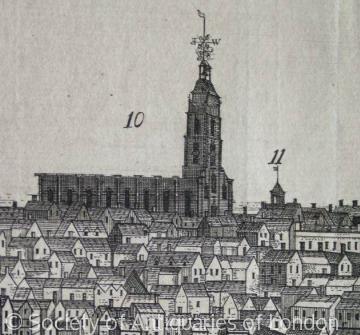Town Churches
 Holy Trinity Church Sunderland as depicted by Samuel Buck c.1720
Holy Trinity Church Sunderland as depicted by Samuel Buck c.1720Modern towns often incorporate several parishes, only one of which is the church of the ancient parish in which the town developed. Other churches may belong to parishes absorbed as the town grew or have been built for new parishes established to serve an increasing population. Some, like St Peter Monkwearmouth, were been monastic churches which became parish churches after the Reformation.
The chief church of a town, whatever its origin, was in the Middle Ages usually the largest and most elaborate building in that place. Many town churches represent a huge investment. This was made either by individuals connected with that place through land or family or by prosperous townsmen, such as the medieval wool merchants of Burford, who contributed individually or co-operatively to the building. Wealthy patrons made bequests in the late 14th century to build the east end St Mary Redcliffe (Bristol). They could afford the best designers and craftsmen and were often conversant with the styles used by their peers elsewhere in the locality. They attempted to translate some of the most fashionable style into the materials and idioms of their area, as can seen at Launceston where the angular patterns of the Perpendicular style were inscribed into the local granite. (Bristol) Indeed St Mary Redcliffe is, according to the architectural historian Sir Nikolaus Pevsner, the parish church ‘most frankly endeavouring to be a cathedral’.
The patrons chose to be commemorated by including their arms in carved decoration and stained glass as did the Pentire and Carminow families at St Kew in Cornwall, by having their figures represented in windows and wall paintings, and by commissioning their own chapels where mass could be said for their souls, as well as stone tombs, brasses and other furnishings. Burford church has many such memorials and one indent of a vanished 15th-century brass bears a merchant’s mark, and at St Mary Redcliffe mayors of Bristol are amongst those commemorated.
The expansion of towns in the 18th and 19th centuries led to the formation of new parishes and the building of new parish churches to serve all types of community. Holy Trinity Sunderland, built in the most fashionable style and materials, was the focus of a quarter of merchants’ houses of similar calibre. Many churches, such as St Michael Bishopwearmouth (Sunderland) were enlarged to suit bigger urban populations. The Roman Catholics and new congregations of non-conformist denominations, such as Methodist and Baptist, built new Christian churches and chapels to patterns which imposed new architectural forms on the urban landscape. In the 20th century especially, those of other faiths, some of whom like Jews had been resident for centuries, established their own distinctive buildings in towns and cities, as can be seen in the port city of Bristol.










